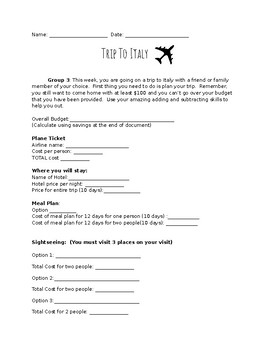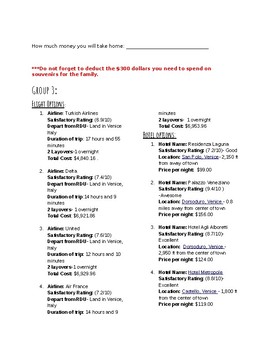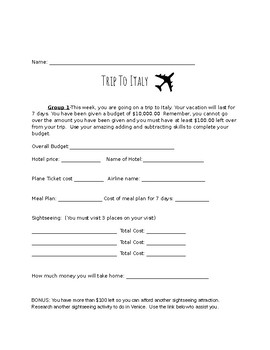Differentiated Trip to Italy
4thGradeNaggSwag
14 Followers
Grade Levels
4th - 5th
Subjects
Resource Type
Standards
CCSS4.NBT.B.4
CCSSRI.4.7
CCSSMP4
Formats Included
- Word Document File
4thGradeNaggSwag
14 Followers
Description
At the end of the adding and subtracting multi-digit numbers unit, students should be able to effectively plan a trip to Italy.
For higher students- Allow them to bring a friend
For Middle students- Allow them to explore their own sight-seeing options and choose between prices of hotels and plane tickets
For low students- Give them only 1 plane ticket option, one food plan, and one hotel. They must still choose their sight seeing options and still calculate the total budget they would need.
Total Pages
Answer Key
N/A
Teaching Duration
N/A
Report this resource to TPT
Reported resources will be reviewed by our team. Report this resource to let us know if this resource violates TPT’s content guidelines.
Standards
to see state-specific standards (only available in the US).
CCSS4.NBT.B.4
Fluently add and subtract multi-digit whole numbers using the standard algorithm.
CCSSRI.4.7
Interpret information presented visually, orally, or quantitatively (e.g., in charts, graphs, diagrams, time lines, animations, or interactive elements on Web pages) and explain how the information contributes to an understanding of the text in which it appears.
CCSSMP4
Model with mathematics. Mathematically proficient students can apply the mathematics they know to solve problems arising in everyday life, society, and the workplace. In early grades, this might be as simple as writing an addition equation to describe a situation. In middle grades, a student might apply proportional reasoning to plan a school event or analyze a problem in the community. By high school, a student might use geometry to solve a design problem or use a function to describe how one quantity of interest depends on another. Mathematically proficient students who can apply what they know are comfortable making assumptions and approximations to simplify a complicated situation, realizing that these may need revision later. They are able to identify important quantities in a practical situation and map their relationships using such tools as diagrams, two-way tables, graphs, flowcharts and formulas. They can analyze those relationships mathematically to draw conclusions. They routinely interpret their mathematical results in the context of the situation and reflect on whether the results make sense, possibly improving the model if it has not served its purpose.





